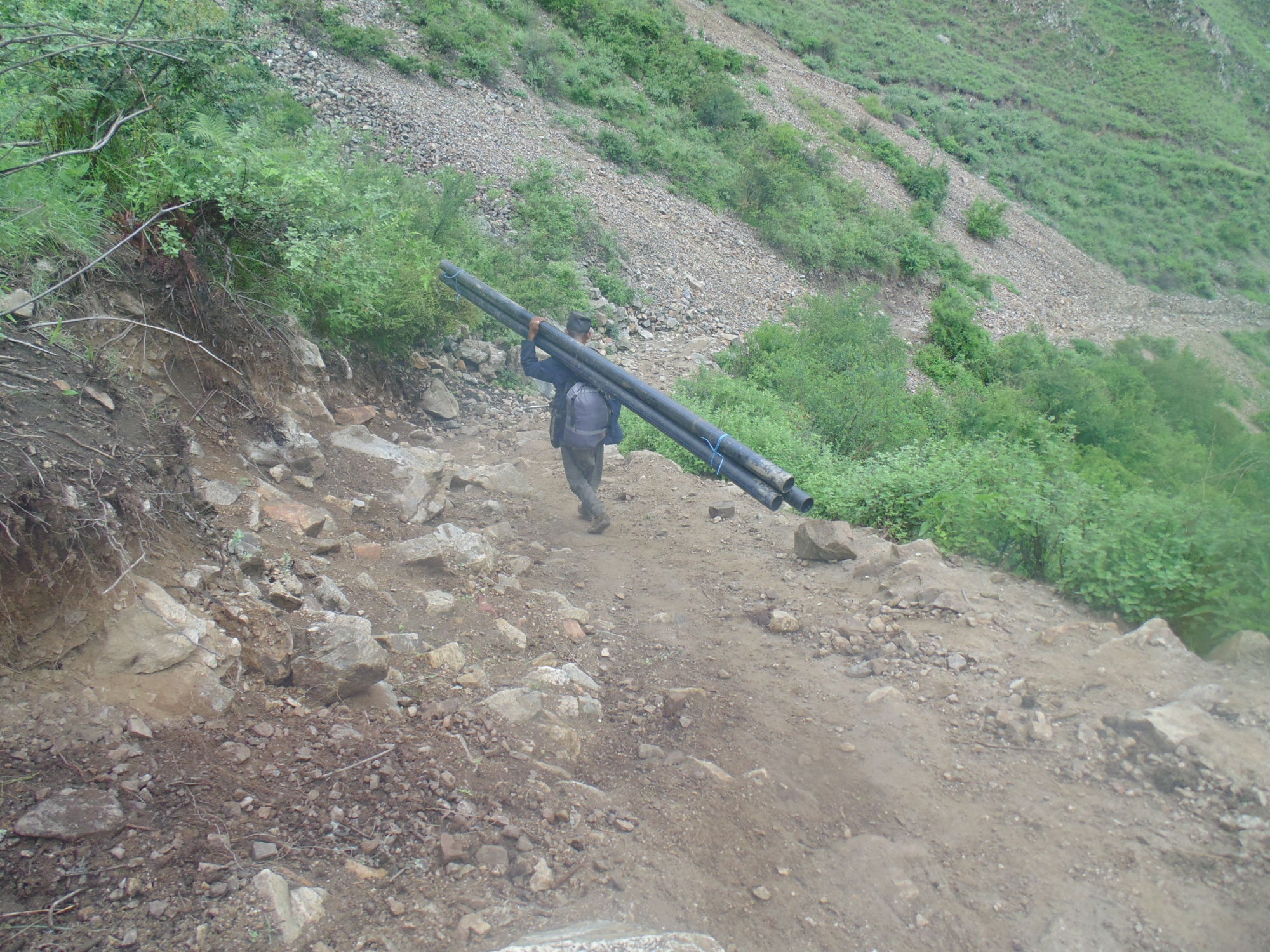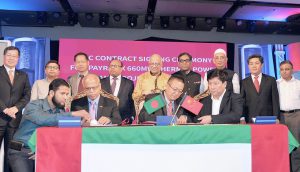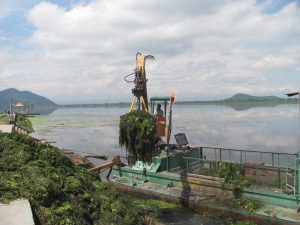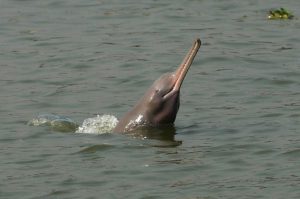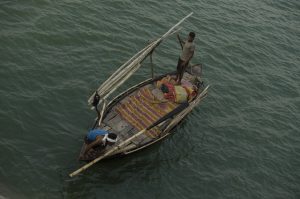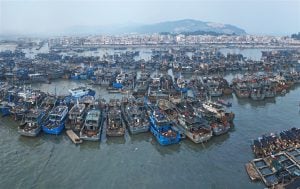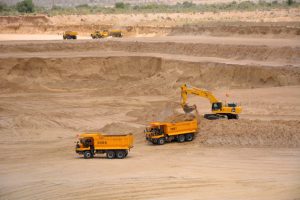In 2015-2016 a drought hit Nepal’s mid-west region. Farmers of Bajhang district found themselves caught in a tragedy of continuing food insecurity and poverty and were forced to migrate to Simikot, the headquarters of neighbouring Humla district, to look for work. According to government, the drought – the worst in 40 years – has exacerbated the region’s economic vulnerability. But there has been little attempt to understand the causes of this insecurity, and more immediately, that of the drought itself.
Far-Western districts like Bajhang and Bajura and mid-Western districts in the Karnali zone – Humla, Jumla, Mugu, Dolpo, Kalikot – have remained in the grip of persistent poverty. In 2011, Humla ranked highest in Nepal on the poverty index, a position it held even in 2001. According to the UNDP’s Human Development Report 2014, it was also among the lowest five districts in terms of education, and child nutrition and the overall Human Development Index.
A reason for this stubborn economic vulnerability is the vertiginous terrain and the corresponding lack of roads, making it difficult for the state, the market, and non-government organisations to access the area to provide services and goods. For instance, some villagers in Humla walk for four days to reach the district headquarters which has the only airport in the region – to collect a sack of rice or buy a piece of corrugated tin to carry back home. The aridity and the terrain make it impossible for even subsistence agriculture and the area’s remoteness from the seat of power in Kathmandu has led to political neglect. But besides these political and social reasons, new research on the ecosystem of the region suggests that the causes might be more complicated.
The dust bowl
The Karnali zone gets its name from the perennial Karnali river that originates in the Tibetan plateau and enters Nepal as Humla Karnali near Khojarnath. It then meanders through the Himalaya collecting smaller feeder rivers to join the Mahakali River at Brahmaghat in the Indian plains to form the Ghaghara, a major tributary of the Ganga. This network of rivers connects the fate of people in Southasia in an elemental way, and any change in river flow in Tibet and Nepal has consequences for India and Bangladesh downstream.
The Karnali river basin consists of 1,461 glaciers and a total area of 1120 sq.km area and a drainage area of 44,000 sq.km most of which is in Nepal. Despite this proximity to rivers and alluvial soil, only 1% of the area is cultivable. In Nepal, approximately 45% of the river basin lies above 4,500 metres and is covered by snow for most of the year. Most of the rest land is between 2500-4500 metres, and is not suitable for intensive agriculture. Since much of the region is also in a partial rain shadow area, rainfall here is low – 80% of it in the months of July and August. Any drastic change to this ecological balance often spells disaster to the people living in the river basin.
The 2015 monsoon rains were a disappointment to the Karnali region. But it was when the region received little snowfall in the winter of 2015-2016 that the people knew they had to prepare, the best they could, for khaderi (drought). People here are no stranger to drought or famine earlier; the region suffered droughts in 2006, 2008, and 2009 and famine in 1960, 1963, 1968, 1972, 1975 and 1996. This time around however, the drought emphasised the increasing weather variability: hailstorm in 2006, heavy snowfall in June 2007, drought in 2008, and floods in 2010.
The drought also led to a shortage of water for domestic consumption. In Maila-7 VDC (village development community, the administrative unit defining a village), in south Humla, all of the six taps in the village with 44 households have run dry. “We constructed the taps with the help of the government few years back, and we noticed the force of the water decreasing, but since the khaderi took hold in April-May, there has been no water in these taps,” says Laxmi Prasad Jaisi, a farmer and president of the village school committee. In Muchu VDC, Tashi Lama, a farmer, tells me how there was very little snow in winter and how “even places that were not dry, now are”. Lumjung Khola, the small feeder stream near his village, now holds a meager cache of water compared to what he has come to know as normal in his 59 years. From all across Karnali the news is similar – no rains, and scanty snowfall had led to the drying of water sources, creating a drought and worsening food security.
Poor monsoon rains led to a sharp drop in the summer crops of paddy, maize and millet, while a poor winter rain meant failed winter crops such as wheat and barley. As a result, between November 2015 and March 2016, around 87 % of Karnali’s population of 172,500, were thought to be ‘highly food insecure’ or ‘moderately insecure’, needing to sell livelihood assets to access food and medicine. Anxiety has forced people to migrate in search for work. The Nepal Food Security Monitoring System’s (NeKSAP), a government agency, reports that migration from Karnali has increased tremendously in this past year; in Mugu district alone, out-migration increased by 25%. In some VDCs, over 80% of Dalit households were found to have at least one member of the family who had migrated out from the region since the drought. Many moved to towns to sell their labour, while others crossed the open border into India.
Speaking climate
“Sir, this is a result of jal-vayu parivartan [climate change],” says Kali Das Shahi when he shows me the shrunken stream near his home in Chhipra VDC. The reduced water in this feeder stream threatens the newly built irrigation canal and the water supply in this hamlet of 17 houses. “We aren’t sure how it happens, but the NGO people have told us that it is jal-vayu parivartan and that we must protect our water sources.” That climate change was the cause of drought is a claim that many local residents who spoke to me made confidently. Dinesh Ghimire, District Climate Change Officer, Nepal Climate Change Support Programme in Simikot encapsulated this view. “A reason for this decrease in productivity and hardship is climate change. Everywhere you look, there are changes that can be perceived because they have been so drastic. The people of the region have been ‘sensitised’ about climate change and how to react to it.”
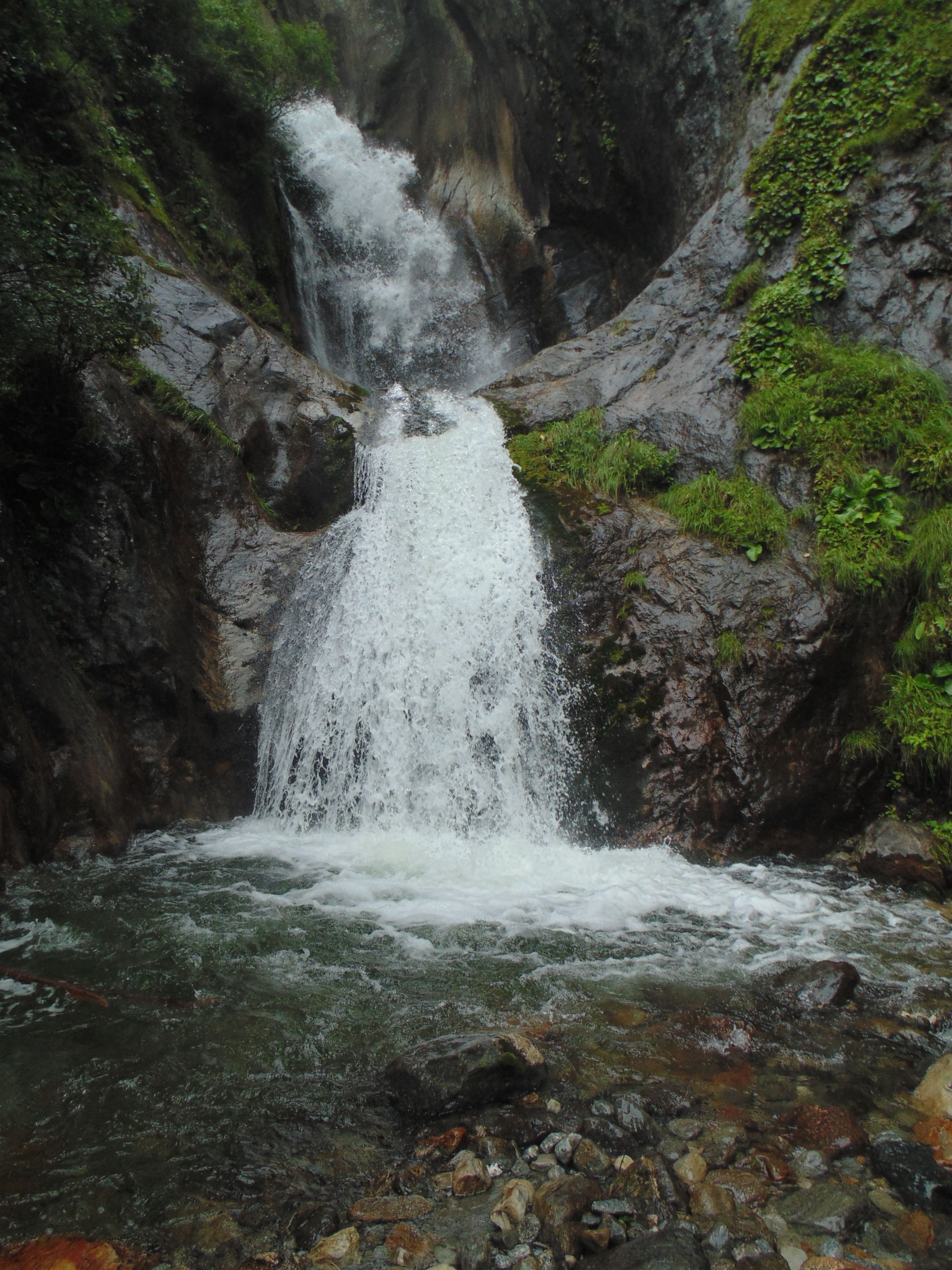
The few environmental scientists researching the Karnali River basin are more ambivalent about the degree to which variation in weather patterns is linked to climate change. The chief reason for their reserve is the lack of reliable data.
A 2015 research paper ‘Impact of Climate Change on Precipitation in the Karnali Basin, Nepal’, presented at the National Symposium on Hydrology and Meteorology in Kathmandu, found that “only a limited number of DHM (Nepal’s Department of Hydrology and Methodology) precipitation stations in the Karnali basin had data of sufficient period of time and of good quality.” Though “natural climatic variability was clearly observed” neither a strong trend nor a “true representation of climate change” could be inferred.
To perform a valid trend analysis, researchers need at least three decade’s worth of reliable data. The data on the Karnali river basin also lacked consistency. Between 1981-2012, the time frame studied by the paper, 22 out of 44 stations had more than 5% data missing, while eight had more than 10% of their data missing. This lack of data adds to the neglect of Karnali by researchers who are already dissuaded by the difficult terrain, says independent researcher Kabi Raj Khatiwada.
Khatiwada is the lead author of a 2016 paper called ‘Hydro-Climatic Variability in the Karnali River Basin of Nepal Himalaya’, published as part of the Asia Pacific Network for Global Change Research (APN). It is the only paper in the last few years which looks at three determinants of climate change: precipitation, temperature and discharge data. Using available data for precipitation from 27 stations and temperature observations from seven stations between 1981 to 2012, Khatiwada’s team found a 10% decline in average precipitation and an increase in both maximum and minimum temperatures, with a faster rise in high elevation areas than in the lowlands.
These changes are also linked to changes in the patterns of precipitation and snowfall, which has a more immediate fallout. The number of rainy days – defined as days with more than 1 mm of precipitation – is in decline in the river basin. The mountain valley, where the average total number of rainy days in a year is already fairly low, faces the sharpest decline at about 1 day per year. In the plains and the hills, the numbers are dropping at a rate of 3 days per decade.
This weakening rain is but one facet of the change taking place. On the flip side, there is evidence of an increasing intensity of rainfall – though the number of rainy days is decreasing, when rainfall occurs, it is intense, often leading to deadly floods and higher runoff of water.
Similarly there has been a decrease in snowfall. Places like Muchu VDC, or even Simikot, where six feet of snow was the norm during winter, receive 2 feet or less. Satellite data used by ICIMOD (International Centre for Integrated Mountain Development) to study the change in rainfall pattern, by comparing the 2015-2016 winter season to the average rainfall figures from the previous 30 years, reinforces these findings. The difference is stark, with many places in the north of the river basin receiving about 35 percent less rainfall than in a normal year.
Declining precipitation not only redices the flow of rivers and smaller streams that crisscross Karnali’s rugged landscape, but has also means the depletion of groundwater reserves, making it impossible for smaller rivers to recharge. In addition to this the rapid rate of deforestation has worsened the water-retention capacity of the area. Villages like Lama’s and Shahi’s, that rely on these smaller rivers or wells for irrigation, for cultivation, and for basic survival, are rendered even more vulnerable.
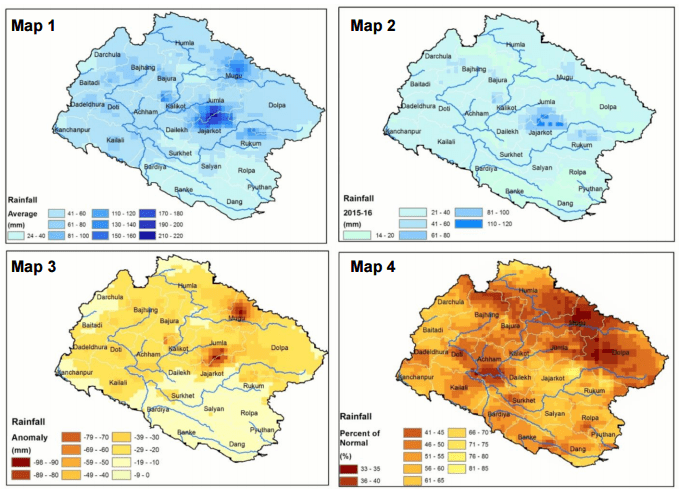
Indeed, the future of economic development in the region, dependent as it is on hydro-power generation, is also at risk. With Karnali river identified as a source of cheap electricity by the Nepal government, any change in the volume of the feeder rivers directly impacts the capacity to generate electricity, whether for revenue generation for the area or direct consumption by the local population. According to July 2016 government estimates, if Nepal grows at a rate of 5% over the next two decades, the country will need a minimum installed capacity of 10,092 MW to meet its energy requirement. A number of projects including the 900 MW Upper Karnali hydropower project, and the Karnali Chisapani Multipurpose Project with an installed capacity of 10,800 MW are being developed along with a number of smaller micro-hydros. These plans are however premised on the reliability of river flow. Though a study of three decades of Karnali river discharge data at Chisapani shows a constant flow of around 16,000m3/s (metric cube per second), the future flow is far from certain.
See also: Nepal’s eternal quest for hydropower – challenges and quakes
Simikot and seven other nearby VDCs get their electricity from the 500 KW Heldung Distribution Center. But in mid-July 2016, one of the generators was not functional and the entire area was without electricity for three days. Equipment that was needed to fix the generator had to be airlifted from Nepalganj in the absence of motorable roads. Alternate sources are being explored but far from replacing hydro power. When I landed at the Simikot airport, I noticed a pile of solar panels lying neglected near the runway. It’s for a nearby mobile network tower an airport official informed me. “When there is no power [electricity] there is no tower [signal].”
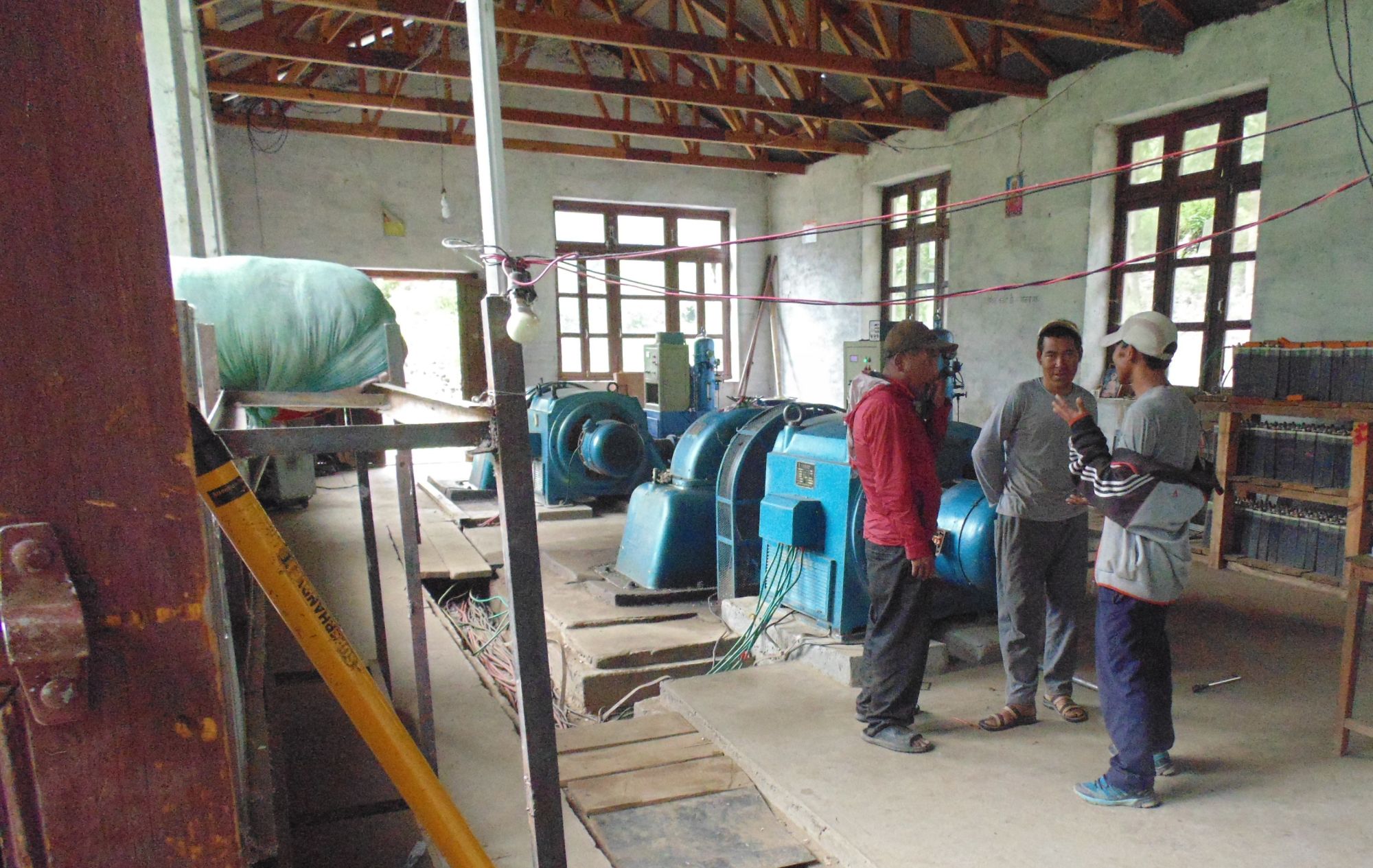
The Heldung Distribution Center has a capacity of 500 KW but manages to produce only 270 KW. The required energy is almost 1 MW. Anirudh Prasad Singh, Branch Officer of the Heldung Distribution Center, tells me that the water source is drying up. “On average, the reservoir level used to be at around 80 cm. Now it has come down to around 35 cm.” A major reason for this is that the Nepal Water Supply Corporation has began to use this river as a source of drinking water for the area as their previous water source, the Humané Khola, has dried up. This decline of flow was sped up by the recent drought, a continuation of which will affect not just energy generation but drinking water supply as well.
The mantra of global climate change and the lack of reliable data delays the action that could be taken to mitigate the crises. Though a 2012 report submitted by the Society of Hydrologist and Meteorologist to the Ministry of Environment, Science and Technology recognised that the “changes in evaporation rates, annual river discharge amounts, seasonal and temporal offsets of hydrological patterns, extreme precipitation events, and increased glacial melt are the most pertinent climate change effects that will impact hydroelectric generation”, it said more data was needed to plan efficiently for the future. The report added that Nepal lacked the infrastructure and resources to effectively respond to the crises of climate change. However if the warning signs remain unaddressed, climate change could adversely affect Nepal’s ecology and cripple hydropower projects.
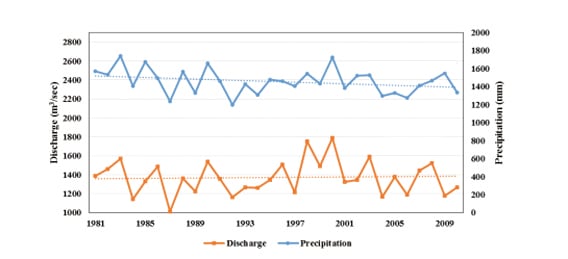
Recent research shows that the amount of river discharge, as recorded at Chisapani, is slightly higher than the rate of precipitation in the Karnali river basin. This implies that the extra runoff is generated by rapid glacier melt. But the lack of adequate data on glacier melt, enlargement of glacier lakes, or even snowfall, means experts can at best surmise the cause of the problem and only provide tentative solutions. In the absence of such information, regions in Nepal and India through which the Karnali flows, remain unprepared for possible disasters.
Crisis of responsibility
Karnali has been suffering from food shortages for over four decades now. In his book Food Crisis in Karnali, human geographer Jagannath Adhikari explores how the continued exploitation of the region by Kathmandu is a major factor in this crisis. Officials from the centre continue to lord over the region, choosing to make it dependent on food aid rather than improving its ability to feed itself. Given this political, economic and social oppression, people in Karnali have come to believe their social position is subservient, he writes. This has meant that locally- produced food is considered inferior to the rice distributed by the Nepal Food Authority, and has perpetuated the belief that development is only possible after the sanction of the centrally-appointed administrators. While Adhikary’s book looks primarily at the political and social causes of Karnali’s endemic vulnerability, recent research on the river basin underlines the interdependency of these themes with environmental factors. Finding an answer to one problem will open up solutions in other areas as well. For instance, addressing deforestation will go a long way in the management of water sources, which in turn can help in irrigating cultivable land. Most importantly, investment in much needed sustainable public infrastructure in the region will tremendously improve economic opportunity and connectivity to hitherto inaccessible markets.
Slok Gyawali is an Assistant Editor with Himal Southasian where this article was first published. This work is supported by a fellowship from the Earth Journalism Network and thethirdpole.net.
